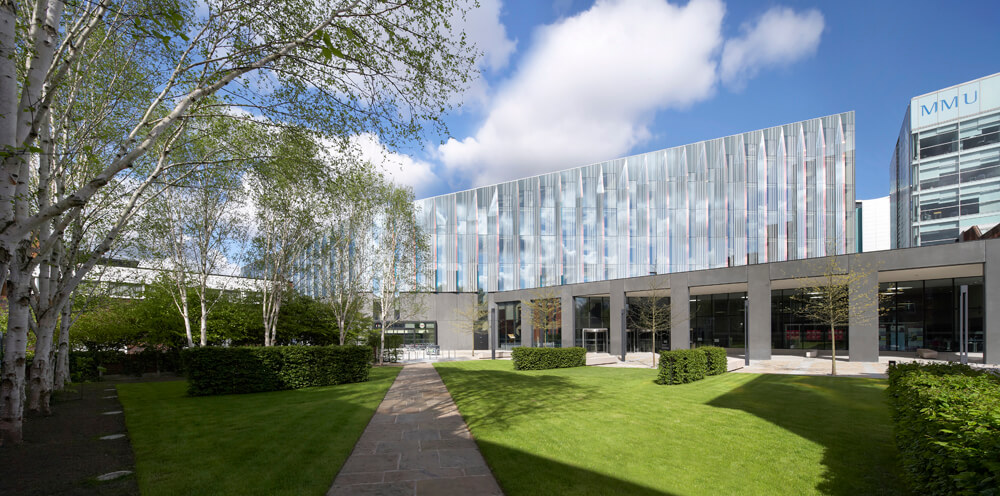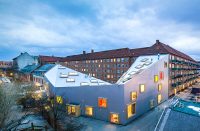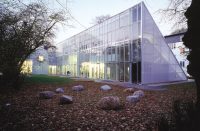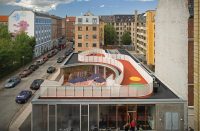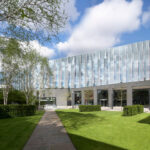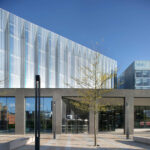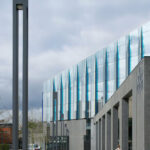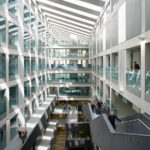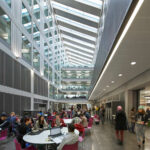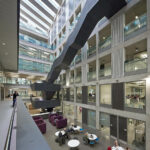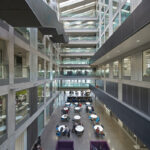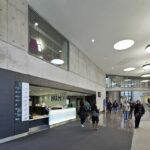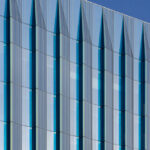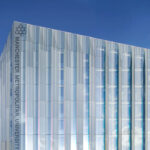Architect(s): Feilden Clegg Bradley Studios
Address: All Saints, All Saints Building, MANCHESTER, United Kingdom
Latitude/Longitude: 53.470996,-2.239000
Photographs: Hufton+Crow
Manchester Metropolitan University’s Business School and Student Hub was its most significant real estate investment since the 1960s. The spectacular new building replaces an outdated business faculty at its Aytoun site.
The new 23,000 square metre facility accommodates 5,000 students and 250 staff and is innovative in its environmental solution, its structure and its materiality.
A unitised dichroic glass envelope playfully casts shards of multicoloured light across the concrete interior, much like a giant kaleidoscope. The Business School encompasses formal teaching spaces, while The Hub offers a vibrant street café ambience where students trade ideas and knowledge. It is the antithesis of the archetypal cloistered halls of academia.
Concept
The faculty accommodation brief consisted of a series of set-piece teaching spaces. However, bringing those areas together required contrasting non-standard ‘social learning spaces’ where ideas could circulate freely.
Our resulting designs evolved in response to a number of questions. How could a building physically manifest an expression of the University’s ambitious, extrovert attitude? And how could we create a study environment akin to the workplaces students would eventually inhabit? The answer was to create an environment that was part corporate HQ, part university.
Context
Higher Education is undergoing major changes. Competition between establishments grows increasingly intense, fees vary, and pressure on funding continues to mount. FCBS was the unanimous choice of the judges in a competition staged to find an architect that could help Manchester Metropolitan University to meet these challenges.
The bold redevelopment of this site forms part of a broader consolidation strategy by the University. By improving existing facilities as it has with the Business School, the University seeks to outshine its rivals and attract new students.
Sustainability
The completed building has achieved BREEAM Excellent targets, exceeding the university’s target for renewables, and improving on the energy use targets.
A ground source heat pump provides heating and cooling, allowing heat from areas that require cooling, such as IT rooms, to be used to heat other areas of the building or to be used to pre-heat the domestic hot water supply. A 1,000msq PV array contributes to off-setting the building’s electrical demands.
Design approach
Collaborating with the artist, Martin Richman, we conceived the building as a jewel-like crystalline object in contrast with the University’s existing red brick buildings. Pleating the façade with light refracting and reflecting dichroic fins animates the structure, its reflections changing with time and seasons.
Inside, three simple parallel 12-metre wide ‘flexible’ floor plates are spaced 12 metres apart, creating two bright, enclosed atria. The taller is occupied by the Business School, the smaller by The Hub. A series of formal and informal ‘social learning spaces’ permeate the building on all levels.
Materials
Chilled water pipe-work is cast into pre-cast concrete floor slabs, delivering cooling to the spaces without any visible mechanical equipment.
Referencing Manchester’s historic industrial warehouses, internally the building is characterised by its honest display of the structure and the robust use of exposed concrete. The concrete is also fundamental to the performance of the building in its thermal mass properties.
Text description provided by the architects.
Client: Manchester Metropolitan University
Construction value: £54,500,000
Contributed by Feilden Clegg Bradley Studios

